Abstract: This article provides a personal view of captive rearing butterflies and moths. Its main objective is to enlighten readers in all aspects of captive rearing so that they develop an informed opinion and are also better-equipped should they attempt captive rearing themselves and thereby avoid the many potential pitfalls.
1914 saw the publication of Frederick Frohawk's seminal work, Natural History of British Butterflies (Frohawk, 1924). This 2-volume masterpiece, with exquisite plates, was the culmination of 24 years (from 1890 to 1914) spent rearing all of the British butterfly species and documenting the findings in meticulous detail (publication was delayed due to the outbreak of war in 1914, and later by insufficient subscribers). The work has never been surpassed and "Frohawk", as it is lovingly known, is still actively referred to today, especially by those wanting to understand the development of the immature stages of the British butterflies. Enthusiasts have continued to rear butterflies and moths to this very day, for a variety of reasons (each of which will be discussed in due course).
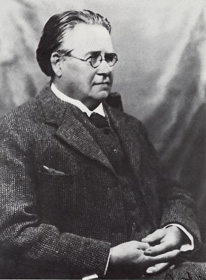 | 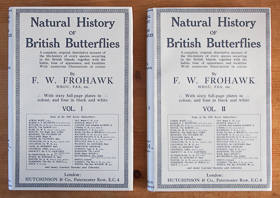 | 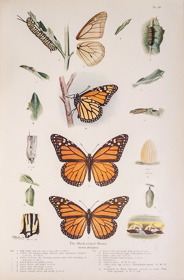 |
| Frederick William Frohawk | Natural History of British Butterflies | Sample plate |
Captive Rearing and Captive Breeding This article focuses on captive rearing, which is the nurturing of a species, typically from eggs or larvae, through to adulthood in one season. Captive breeding goes further and implies the continuation of stock over one or more subsequent generations.
However, captive rearing is an emotive subject that has resulted in diametrically opposed views; there are those that frown upon all forms of captive rearing on one side, and those that see captive rearing as an obligation (to help boost numbers) on the other. The purpose of this article is to provide what I hope is a balanced, yet thought-provoking, personal view. It is not intended to present a position endorsed by Dispar, its sister website, UK Butterflies (I have affiliations with both), Butterfly Conservation or any other individual or organisation. Rather, its main objective is to simply enlighten readers in all aspects of captive rearing so that they develop an informed opinion and are also better-equipped should they attempt captive rearing themselves and thereby avoid the many potential pitfalls.
My own experiences of captive rearing are primarily with respect to British butterfly species (as well as a few moth species, especially the hawk-moths, when I was much younger) and this is reflected in this article. However, all of the key points made in this article apply equally to moths. This article is also aimed primarily at individuals looking to rear only a small number of any given species and not those looking to carry out large-scale (re)introductions. The latter is best left to the experts who will already be more than familiar with the contents of this introductory text.
There are several motives given for captive rearing although not all can be justified, in my opinion.
I still remember my first captive rearing effort when I was aged nine: a "woolly bear" caterpillar that I found in the garden was placed in a jam jar along with some grass, dock and stinging nettles (I had no idea what it actually fed on, so I hedged my bets). I don't remember much else, other than a spectacular Garden Tiger moth (Arctia caja) emerging some time after and I've been "hooked" on immature stages and the amazing lifecycle of our Lepidoptera ever since.
In general, captive rearing as a means of encouraging the younger generation to take an active interest in the natural world, as well as educate them (I am sure that "complete metamorphosis" is still part of the biology curriculum of many education authorities), gets my vote. This is also recognised by the Butterfly Conservation charity who endorse a Painted Lady (Vanessa cardui) rearing kit (Insect Lore, 2014). Butterfly Conservation (2010a) states that "Taking for captive rearing purposes can have a legitimate educational objective and can be a useful way of understanding some of the details of the life history of butterflies and moths" (but that scarce species should not be taken for this purpose).
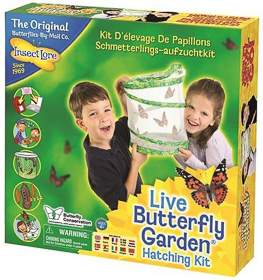 |
| Insect Lore rearing kit |
I continue with captive rearing to this day and it has allowed me to experience and study the lifecycle of many species that I would have had no chance of studying in the wild. This is either because the immature stages are extremely difficult to locate in the wild or because a prohibitive amount of travel would be involved. I personally get a great deal of enjoyment from making personal observations, especially when they differ from, or elaborate upon, what has been previously written. But the primary reasons for captive rearing are to record the lifecycle of the species concerned (and make a photographic record along the way), increase my own knowledge in the process and disseminate this knowledge to the broader community of enthusiasts. The greatest satisfaction, however, is watching a released adult take its first flight in the wild.
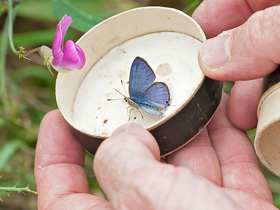 |
| Releasing a British Long-tailed Blue Taken from this article by Mark Colvin Image © Colin Knight |
Vince Massimo has captive-reared several species local to him, which are excellent examples of such study. All of these articles can be found on the Dispar website (Dispar, 2014) and an introduction can be found in Massimo (2014).
Ecology is the branch of biology that deals with the relations of organisms to one another and to their physical surroundings. For example, captive rearing can help determine the suitability of new larval foodplants as species respond to climate change and alter their range beyond the distribution of existing foodplants. A case in point is the Brown Argus butterfly (Aricia agestis) which has recently switched from using Common Rock-rose (Helianthemum nummularium) to Geranium species at the northern limit of its range in the British Isles (Pateman et al., 2012).
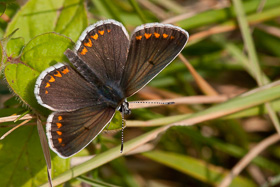 | 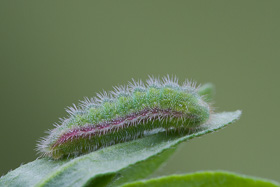 |
| Brown Argus Image © Peter Eeles | Brown Argus larva on Common Rock-rose Image © Peter Eeles |
Another example of captive rearing aiding ecological studies is related to the Small Tortoiseshell (Aglais urticae) decline in the late 2000s and the possible connection with the increased presence of the parasitic tachinid fly, Sturmia bella. Enthusiasts were encouraged to rear batches of Small Tortoiseshell (A. urticae) larvae and send the pupae of any parasitic flies that emerged to the researchers undertaking the analysis (Lewis and Hamer, 2009).
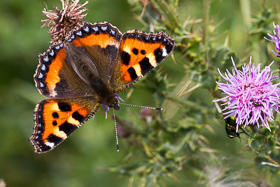 | 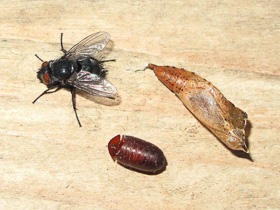 |
| Small Tortoiseshell Image © Peter Eeles | Small White pupa with the tachinid fly (and pupal case of) Epicampocera succincta Image © Vince Massimo |
Some enthusiasts undertake captive rearing in order to better understand the genetic makeup of their subject and to test out theories. For example, were it not for captive rearing experiments, then we would not know that the valesina form of Silver-washed Fritillary (Argynnis paphia) is not only sex-linked (it appears only in the female) but that the allele (a form of a particular gene) that determines if the adult is valesina is dominant. This is most unexpected when one considers the small number of valesina females that fly in a typical colony and which would suggest, incorrectly, that the allele controlling this form is recessive. Dominant and recessive alleles are described in some detail in Eeles (2010).
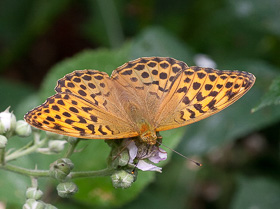 | 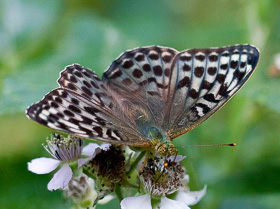 |
| Silver-washed Fritillary female Image © Peter Eeles | Silver-washed Fritillary female f. valesina Image © Peter Eeles |
Captive breeding (where multiple generations are studied) allows for more complex analyses to be performed, such as determining if certain characteristics of the adults are genetically or environmentally controlled. This has been of particular interest to those studying aberrations. Butterflies and moths are good subjects in this regard, since their relatively short lifecycle means that results can be observed in just a few seasons.
Ford (1945) laid down a challenge to all enthusiasts to help discover an example of a gene having more than two forms (a phenomenon described as "multiple allelomorphs" or, simply, "multiple alleles") in a British butterfly. This was more than theory; examples had been found in foreign butterflies, moths and other insect groups at the time. Based on breeding work carried out by Martin White (which started in 1988), Barrington and White (2005) published the first known occurrence of multiple alleles in a British butterfly. It was found that a single gene locus in the Large Heath (Coenonympha tullia) produced three forms, resulting in adult butterflies that were either normal, ab. lunaris (which has a grey ground colour) or ab. ejecta (which has an orange ground colour). Additional forms were also said to occur in the parent population but that more research was required to determine if they resulted from the same gene locus.
There are many good examples of captive rearing aiding conservation. One example is the conservation of the Marsh Fritillary (Euphydryas aurinia) in Cumbria (Cumbria Wildlife, n.d.). In 2004 only 2 larval webs were found in the last remaining Cumbrian colony. These were removed, under license, with the intent of rearing through sufficiently large numbers to ensure the survival of this colony. Unfortunately, due to the weakened gene pool, it was necessary to introduce stock from Argyll in Scotland, which was genetically similar to the Cumbrian colony. This approach, of mixing gene pools, was vindicated when trials showed that specimens reared purely from Cumbrian stock did not survive, whereas those reared from the mixed breeding of Cumbrian and Scottish stock flourished and have since been reintroduced back into the wild. If anything, it is a shame that nothing was done about the Cumbrian colonies sooner so that a "pure bred" line could have been maintained.
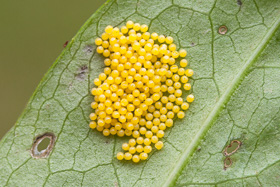 | 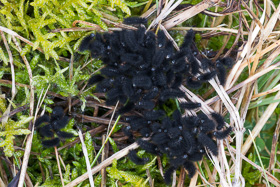 |
| Marsh Fritillary egg batch Image © Peter Eeles | Marsh Fritillary larvae Image © Peter Eeles |
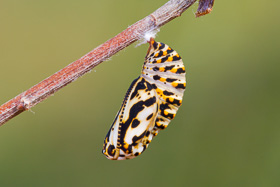 | 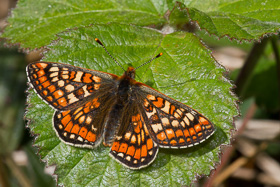 |
| Marsh Fritillary pupa Image © Peter Eeles | Marsh Fritillary Image © Peter Eeles |
The most notable example of captive rearing being used to aid conservation is the reintroduction of the Large Blue (Maculinea arion) into the British Isles. In this case, eggs were collected, under license, from Öland in Sweden. The resulting larvae were reared on thyme and were eventually put down at sites on Dartmoor as summarised by David Simcox in Eeles (2008). The rest, as they say, is history and the Large Blue project is the longest running and most successful conservation project on an insect anywhere in the world.
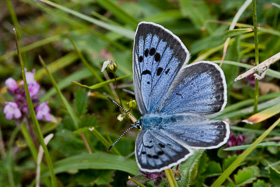 |
| Large Blue female - the progeny of Swedish stock Image © Peter Eeles |
Oates and Warren (1990) conducted a review of butterfly introductions and nearly half were conducted for conservation reasons (although these were not all endorsed by conservation bodies).
Many enthusiasts will have come across fallen trees, flailed hedges, strimmed verges and other situations that leaves any immature stages in a precarious position. I have personally "rescued" Purple Hairstreak (Favonius quercus) ova from a number of oaks that were either blown down or felled, Dingy Skipper (Erynnis tages) ova that were laid on Bird's-foot Trefoil (Lotus corniculatus) that was growing in the middle of a footpath, Small Tortoiseshell (A. urticae) larvae whose nettle patch had been strimmed in a local park, and even Small White (Pieris rapae) larvae which were feeding away on some cabbages in a garden centre (the cashier must have thought I was a madman when I told her that the only reason I was buying the cabbages was because of the caterpillars on them).
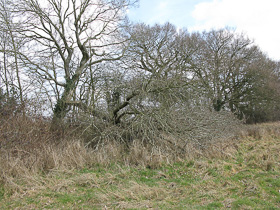 | 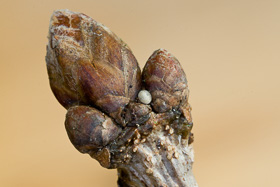 |
| Fallen oak containing Purple Hairstreak ova Image © Peter Eeles | Purple Hairstreak ovum Image © Peter Eeles |
Some of these rescues have simply resulted in the casualties being relocated somewhere more suitable, but I have also taken the liberty of rearing some through in order to study their lifecycle. Of course, acting on such a small scale is not aiding conservation per-se, but it is helping the individual creatures concerned.
The days when every enthusiast had their own reference collection of dead specimens are largely a thing of the past and I am not suggesting that enthusiasts suddenly undertake captive rearing in order to build such a collection. However, I thought it was worth noting that Cribb (2001) states that obtaining a single gravid female and then rearing the offspring through to adulthood, in order to obtain a series of perfect specimens, is "the least destructive method of collecting" and "frequently allows the collector to return live specimens to the original locality of the parent insect".
It should be said, however, that collections can be extremely valuable. For example, the specimens housed in museums contain vast amounts of valuable data since, when correctly labeled, they provide us with historic information of sites and flight times. These can then be correlated with present-day data to help us understand changes in emergence times and distribution, which can themselves be correlated with climate change.
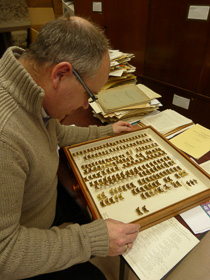 |
| The author examining historic Chequered Skipper specimens Image © Mark Colvin |
Collecting and Conservation Collecting for conservation is not a contradiction. For example, distinguishing populations of Wood White (Leptidea sinapis) and Cryptic Wood White (Leptidea juvernica) and many species of moth (especially micro moths, to monitor distribution and distribution trends) can only be achieved by examining the adult genitalia since the species are too similar to tell apart based on their external appearance. There is even a group dedicated to sharing best practice in this area (Lepidoptera Dissection Group, 2014). As summarised in Butterfly Conservation (2010a), "For some moth families and critical species, along with many other insect groups, responsible collecting is still an important way of gaining taxonomic expertise and increasing vital scientific knowledge of conservation value".
The reference collection of most enthusiasts is more likely to be of photos and photography can be a valuable complement to captive rearing, where photos of the lifecycle, aberrations, parasitic flies and the like can all add to our collective knowledge. The UK Butterflies website (UK Butterflies, 2014) goes out of its way to make available photos that have been contributed by its members and has, over time, managed to become one of the most comprehensive libraries of images of British butterflies anywhere. These images have been used far and wide, in articles, books, research papers, educational materials, publicity and marketing materials, calendars, DVDs, mobile apps and other products and just goes to show how valuable such a reference can be. The differentiator is that all images are of living creatures and images of immature stages are in particular demand.
I am not suggesting for one minute that readers set up a business founded upon captive rearing, but simply wanted to note that several such organisations do exist, such as the Insect Lore example given earlier (Insect Lore, 2014). Butterfly houses are another example. While it could be said that such organisations foster an interest in butterflies and moths, this cannot, unfortunately, be said of them all. The challenge is separating the good from the bad and this is not at all easy.
To give a counter example, there are organisations that breed butterflies for the sole purpose of selling them for release at weddings, funerals, christenings and the like (just Google "Wedding butterfly release" to see examples). Aside from the potential issues associated with any release (which are discussed in detail later), I personally find this rather distasteful because it is exploitative, does nothing for the creatures involved and gives the impression that butterflies are a commodity. I hate to think how this is seen by young children who are easily influenced. While the children's parents may be ignorant of the issues, the dealers in question are not.
My belief is that almost everyone undertaking a captive rearing project would like to see the resulting adults fly free to lead a productive life (which, in effect, means the opportunity to procreate). There is always one question that should be asked before embarking on any captive rearing project: "What will you do with the adults?". This simple question is surprisingly difficult to answer if you care about the welfare of the creatures themselves due to the constraints described below. It should be noted that these constraints apply primarily to species that live in close-knit colonies where a small change can have a big impact, rather than more widespread and mobile species.
Unsurprisingly, the law has something to say about releasing (as well as taking specimens from the wild, which is discussed later in this article).
In England and Wales, releasing is covered by the Wildlife and Countryside Act (1981). Under section 14(1) of the act it is an offence, without a permit, to "release or cause to escape into the wild" any animal which "is of a kind which is not ordinarily resident in and is not a regular visitor to Great Britain in the wild state". This may also apply to non-native stock (of native species) and non-native subspecies (of native species), but the position is unclear.
In Scotland releasing is covered by the Nature Conservation (Scotland) Act 2004 and in Northern Ireland releasing is covered by the Wildlife (Northern Ireland) Order (1985). Both are very similar to the Wildlife and Countryside Act and have almost identical wording with respect to releases. The Wildlife (Isle of Man) Act (1990) makes no mention of releases.
In the Republic of Ireland, both breeding and releasing are covered by Regulation 49 of the European Communities (Birds and Natural Habitats) Regulations (2011). This regulation states that, without a permit, "Any person who breeds, reproduces or releases or allows or causes to disperse or escape from confinement, any animal which ... is not ordinarily resident in or is not a regular visitor to the State in a wild state ... shall be guilty of an offence".
Specific provisions are also made for specially-designated land when it comes to releases. For example, a Site of Special Scientific Interest (SSSI) will typically disallow, without consent, "The release into the site of any wild, feral or domestic animal, plant or seed" (SSSI, 2013). The National Trust bylaws (National Trust, 1965) makes similar provisions: "No unauthorised person shall knowingly bring and leave on or in or knowingly permit to be brought on to and left on or in Trust Property any living creature in such circumstances that the same would be likely to reproduce or propagate itself or cause damage to Trust Property or plant or animal life thereon". In essence, this legalese means that no release of any butterfly or moth, in any of their stages, is permitted. National and local nature reserves, other organisations and private landowners may make similar provisions.
There are many examples where the law has been broken, such as the deliberate release of the non-native Marbled Fritillary (Brenthis daphne) into Finemere Wood (a Wildlife Trust nature reserve) in Buckinghamshire, which persisted between 2007 and 2010. Accidental (but illegal) releases happen all the time from butterfly farms too and just about every species bred in such farms has, at one time or another, been recorded "in the wild".
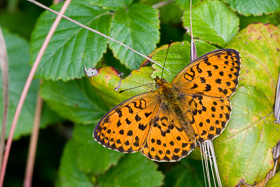 |
| Marbled Fritillary Image © Peter Eeles |
The provenance of any livestock (where it came from) is particularly important if you intend to release the adults. Livestock purchased from dealers may come from a different region or even country to that of any intended release site and the introduction of genes from a different gene pool may not be favourable for the colony as a whole. Specifically, any genetic adaptations that are considered favourable in the source environment (from where the livestock originates) may prove to be a distinct disadvantage in the target environment. The resulting gene pool would therefore be weakened as a result. This is why the general advice is to always to release the adults from wherever the livestock was obtained.
As a hypothetical example, consider the Large Heath (C. tullia), where the eye spots on the underside of the adult butterfly can vary considerably between colonies. Those in the north have almost no spots at all with adults looking like a large Small Heath (Coenonympha pamphilus), while those in the south have very distinctive spots. This has given rise to 3 named subspecies. Those with the least distinct spots are referred to as ssp. scotica, those with the most distinct spots as ssp. davus and those that are intermediate as ssp. polydama. Brakefield and Shreeve (1992) describe, in detail, the reason for this variation, which is believed to be natural selection based on predation by birds. The cooler climate in the north, along with more inclement weather, results in less-active adults whose plain undersides make them difficult to find while at rest. Adults further south, on the other hand, are much more active and are more likely to attract the attention of birds as a result. In this case, the distinct eye spots deflect the bird's attention away from the body.
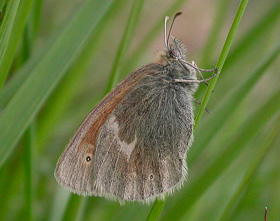 | 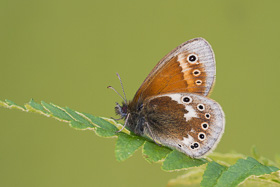 | 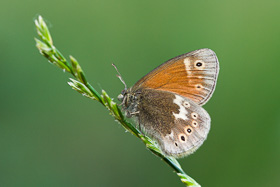 |
| Large Heath ssp. scotica Image © Adrian Riley | Large Heath ssp. davus Image © Peter Eeles | Large Heath ssp. polydama Image © Peter Eeles |
Now imagine that ssp. davus is introduced into an area where ssp. scotica flies. Should any adults survive long enough to mate and for eggs to be laid, then any resulting offspring will potentially be at a disadvantage in their environment, should the cooler climate result in less active adults that are more easily found due to the prominence of their spots. Of course, the more adults that are released, the bigger the problem, resulting in the exact opposite of what was intended. This is therefore a risk that is not worth taking when there is an existing population of the species.
However, it should be said that supplementing the gene pool can have a positive effect, as shown in the example of the Cumbrian Marsh Fritillary (E. aurinia) given earlier, and that the ability for a population to thrive can outweigh any predation that might occur while natural selection takes effect. "Experiments with hybridised Large Heath especially selected for greater spotting and higher than normal proportions of colour forms were introduced into a vacated Large Heath territory brought back to a suitable standard by sympathetic management. Within a few generations such forms were reduced to levels previously encountered, presumably by natural selection. The butterflies did, however, show an almost immediate increase in density and expansion following their release." (White, 2014. pers. comm.).
Livestock may also be obtained that is the result of inbreeding over many generations and is therefore genetically inferior, to the point that the livestock may exhibit some trait that natural selection would have dealt with if it were allowed (conversely, hybrid populations can demonstrate an increased potential for success). Orr (1994) lists indicative signs of excessive inbreeding: "Inbreeding depression in butterflies is manifested in many ways, including egg inviability, retarded larval development and premature mortality, failure to complete pupation and increased mortality during the pupal stage and at eclosion, and reduction in size of adults with an associated loss of vigour and reduced fecundity". Anyone captive rearing from generation to generation typically supplements the available gene pool by introducing new livestock to combat this. Genetic weakness can also occur in the wild and an example of the Marsh Fritillary (E. aurinia) in Cumbria was given earlier. This population will have gone through countless genetic bottlenecks over hundreds of years, but the final and doubtlessly inbred butterflies did show abnormal asymmetry and infertility in captivity.
An alternative view is provided by White (2014. pers. comm.): "Poor husbandry is the normal culprit when inbreeding is cited as the cause of some failure. It would take a lot of generations of very close inbreeding to have any ill effect on stocks. The closest example of inbreeding we have is doubtless the Dutch Large Copper (Lycaena dispar ssp. batavus) which has been captive bred in Britain over a period of more than eighty years (the longest time that any species of butterfly has been kept isolated in captivity anywhere in the world). The stock exhibits none of the characteristics usually attributed to inbreeding. Indeed the adults are now larger than they were in 1930's specimens".
However, Nicholls and Pullin (2000) showed that captive-bred Large Copper (L. dispar ssp. batavus) larvae, overwintering in England, suffered substantially greater mortality than a Dutch population in its native habitat. Also, survival of wild-caught larvae, collected in the Netherlands, was superior to that of captive-reared British stock. From this, the authors inferred a genetic divergence of the two stocks and suggested that reintroduction of this species should involve direct translocation from wild populations rather than using captive-bred stock.
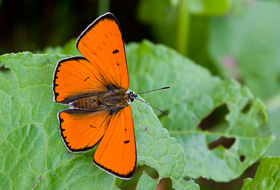 | 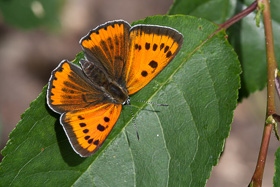 |
| Large Copper ssp. batavus male Image © Peter Eeles | Large Copper ssp. batavus female Image © Peter Eeles |
Care should also be taken when releasing adults from the same two parents into the same site en masse. Theory would suggest that the result is a weakened gene pool since there is little genetic diversity present in the released adults and this is carried forward as the introduced adults pair with the extant population and each other. Again, the result is the opposite of what was intended; rather than seeing an increase in numbers, the weakened gene pool results in fewer viable adults in the generations that immediately follow the release.
However, practice would not seem to substantiate this theory. In quantifying the extraordinary success of the Large Blue (M. arion) reintroduction, Andersen et al. (2014) demonstrate that the introduced populations now have as much genetic diversity as the source populations from Öland, despite the limited number of individuals originally introduced. There is also "significant genetic differentiation among reintroduced UK populations only a few kilometres apart". Similarly, Peter Cribb (Cribb, 2001) managed to continuously breed the Marsh Fritillary (E. aurinia) butterfly in his garden for nearly 40 years despite the stock originating from a single mated female captured at Hog Wood in Sussex.
Many enthusiasts that have attempted captive rearing will be all-too-aware of the potential for disease to strike. Altizer and de Roode (2010) provide a nice summary of the different causes of disease. While the impact of parasitic flies and wasps is relatively-easy to diagnose, the presence of pathogens (bacteria, viruses, protozoa, fungi or other microorganisms) is not, since they are invisible to the naked eye.
Introducing diseased stock into the wild is not a problem as such, especially since pathogens (and parasites) are a natural occurrence and must have originated in the wild in the first place. One concern, however, is that disease may be introduced from the source site that was not present in the target site. This concern is multiplied when one considers imported stock, where the introduction of non-native parasites and pathogens is a real possibility. A second concern is with regard to the amount of disease, which can run rife in captive rearing conditions if larval frass is left in situ, a diseased larva or pupa is not dealt with, larval foodplant is left to deteriorate and so on. Going hungry, being too crowded, eating food that is too wet, and major temperature changes are also stress factors that can cause disease outbreaks in moth and butterfly larvae. Fungal disease is a particular hazard when overwintering livestock and is usually due to excessive moisture and poor ventilation.
Furthermore, pathogens can spread extremely easily since many are air-borne. Pathogens can infect the shells of any eggs that have yet to hatch (and subsequently get ingested by the larva when it eats its eggshell), the larval foodplant (and ultimately get ingested by any larvae), the larval skin (which may be ingested by the larva following a skin change) and so on. The presence of any resulting disease can manifest itself in many different ways but the first sign is often a discoloured larva hanging head down and surrounded by bodily fluids that are contaminating nearby foodplant and container.
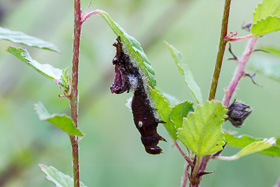 |
| Diseased larva (unknown species, Barbados) Image © Peter Eeles |
In the wild, the presence of pathogens is less obvious. Altizer and de Roode (2010) suggest that "This is probably because in the wild, butterflies and caterpillars that die from disease can quickly disintegrate and disappear, leaving little trace of infection. In other cases, insects harboring pathogens might show only subtle outward signs of infection, and disease-causing microbes can be hard to detect without viewing squashed bits of insects under a microscope and using advanced diagnostic guides". In captivity, as mentioned above, pathogens can multiply if conditions are not as sterile as possible or rearing conditions are not suitable (such as overcrowded larvae). It is therefore easy to see that there is a risk of spreading diseases into wild populations, especially from high density breeding and releasing programmes.
Uncoordinated releases make it difficult to truly assess the effect of conservation efforts, should the released stock have the potential to skew the measurements being used as conservation indicators. For example, following a period of habitat management at a site, then it is preferable that species are allowed to (re)colonise naturally before any attempt is made at (re)introduction, as endorsed in Butterfly Conservation (2010b). In other words, once a habitat has been restored or created, then it is much better for nature to takes its course to prove (or disprove) that the habitat is, indeed, suitable. If a managed site is suddenly the target of a well-intentioned but unauthorised release of a target species, then there is no way to determine if the habitat is suitable for this species or not. Worryingly, the habitat management regime may be considered suitable (because the species count is artificially high) when, in fact, some adjustment is in order.
Measurement of distribution (and distribution trends) can also be disrupted by uncoordinated releases. Oates (2001) gives an example of a time-consuming analysis of an apparent remnant Large Tortoiseshell (Nymphalis polychloros) colony in West Sussex, only to find out that it was an attempted introduction. Oates also summarises the disruption noted in The Millennium Atlas of Butterflies in Britain and Ireland (Asher, 2001): "The atlas admits that the edge of range status and apparent expansion of at least eight species has been confused by unreported releases ... This suggests that what is arguably the single most important knowledge base from which an understanding of species' distributions can develop has been to an extent devalued by unreported releases".
Butterfly Conservation, as an organisation, is at the heart of recording and monitoring butterfly and moth populations in the UK. The vast majority of records are provided by thousands of individual volunteers who go out of their way to walk transects and report less formal sightings each year. Uncoordinated releases that interfere with conservation efforts are not, therefore, simply disruptive to whatever recording is happening; they are also fundamentally selfish if they bring into question the records from volunteers.
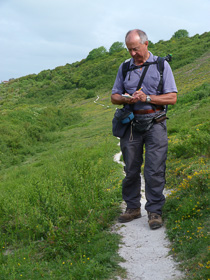 |
| Colin Knight walking the transect at Mill Hill, Sussex Image © Mark Colvin |
So, on the one hand, we don't want to disrupt conservation efforts but, on the other, we want to give butterflies and moths a helping hand when needed and some individuals have done just that, but in an uncoordinated manner. Butterfly Conservation has provided a simple solution: while it endorses a restrained approach, it would like to be informed (anonymously if preferred) of any uncoordinated releases so that they can be taken into account. Any information on releases can be sent to Butterfly Conservation, Manor Yard, East Lulworth, Wareham, Dorset, BH20 5QP.
Unfortunately, this is one particular area where some breeders seem reluctant to share their information. One reason given is that they see the sharing of their information as a one-way street, where personal data is provided and used, but requests for information are declined. This should not be surprising if the information being requested is sensitive. There is also a sense that research undertaken by private individuals is not endorsed (and should be under the control of a single body) which, even if unfounded, is an impression that harbours ill feeling. To say that this impasse is a shame would be an understatement since, at the end of the day, you are talking about two parties (Butterfly Conservation and experienced breeders) who want the same thing: to see the populations of our butterflies and moths flourish once again.
Butterfly Conservation has also recently made its position clear with regard to the "conservation" of species that are potentially new to the British Isles (a distinct possibility with climate change) and has released guidelines on "Sightings of non-native butterflies and moths: Guidance for branches" (Butterfly Conservation, 2014). It is no coincidence that this followed the appearance of a colony of Map (Araschnia levana) butterflies near Swanage which was, it turned out, an accidental release, although the explanation given for it being "accidental" is disputed (Hulme, 2014). The request from Butterfly Conservation is, quite sensibly, that "The rearing and further release of the species should be discouraged so that we can learn the natural behaviour of the species in our climatic conditions".
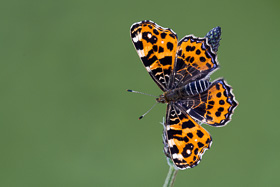 | 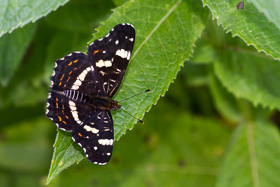 |
| Map (spring form) Image © Peter Eeles | Map (summer form) Image © Peter Eeles |
Assisted Colonisation It has been argued that our often-fragmented landscape prevents certain less-mobile species from reaching new suitable habitat and that the only way that these species can disperse and reach such habitat is with our intervention and where captive rearing and release may have a part to play.
Matthew Oates (Oates, 2001) summed up the situation nicely: "The extent of habitat fragmentation and isolation, together with the increasingly hostile nature of the intervening land, means that many butterflies are not able to colonise distant sites, the result being unoccupied habitat in apparently suitable condition ... Releases are therefore seen as a way of restocking the landscape that has been degraded by the ravages of the twentieth century". However, Oates goes on to suggest that a restrained approach is needed, where the root causes of fragmentation and isolation are dealt with first and this is the view also taken by Butterfly Conservation. Landscapes would be restored by "ending damaging agricultural and forestry practices and by improving the management of nature conservation sites, and by enlarging and connecting them".
McLachlan, Hellmann and Schwartz (2007) take things further: "If circumventing climate-driven extinction is a conservation priority, then assisted migration must be considered a management option. Compelling evidence suggests that climate change will be a significant driver of extinction. Researchers typically conclude that mitigating climate change and providing reserve networks that foster connectivity and movement should be a priority. Ecologists must recognize, however, that even optimistic estimates of natural movement may be insufficient for species to keep pace with climate change. Assisted migration is a contentious issue that places different conservation objectives at odds with one another. This element of debate, together with the growing risk of biodiversity loss under climate change, means that now is the time for the conservation community to consider assisted migration. Our intent here is to highlight the problem caused by a lack of a scientifically based policy on assisted migration, suggest a spectrum of policy options, and outline a framework for moving toward a consensus on this emerging conservation dilemma".
Thomas (2011) adds to the discussion: "The argument that translocations will create 'unnatural' communities is not particularly relevant in the world today. A philosophy of conserving the composition of biological communities as they are, or restoring them to some specified (or imagined) historical state, sits uneasily with the reality of environmental and biological change" and goes on to say "I suggest that translocation represents one of the principal means of saving species from extinction from climate change; in conjunction with maintaining large areas of high-quality (low human impact) habitats".
Thomas goes on to describe the concept of an Assisted Regional Colonisation (ARC) area and suggests that Britain is an ideal recipient location for certain translocated species, citing Provence Chalk Hill Blue (Polyommatus hispanus) and de Prunner's Ringlet (Erebia triaria) as candidate threatened species. The article is thought provoking and makes for interesting reading.
A practical example of assisted colonisation is described in Willis et al. (2009) where the Marbled White (Melanargia galathea) and Small Skipper (Thymelicus sylvestris) were each introduced into separate sites in northern England, approximately 65 and 35 km beyond their respective northerly limit (and where the sites were predicted to be suitable in terms of both climate and habitat). The introduced populations grew and expanded their range over 6 years (2001-2006) and were still thriving in 2008, proving that a well-planned assisted colonisation can be successful and suggesting that such an approach may be a feasible and cost-effective means of enabling certain species to track climatic change.
While well-meaning enthusiasts may feel encouraged to attempt such an introduction themselves, it should be remembered that such studies have been undertaken (and documented) simply to understand their potential as a conservation tool. These studies have also been carefully conducted to ensure that there is no confusion with natural spread.
It is no good captive rearing if the resulting adults are doomed the moment you release them (and by "doomed", I mean that they have no opportunity to procreate). If any butterfly or moth is to lead a fruitful adult life, then it must be released at the right time and in the right place. In many cases the solution is simple (especially when rearing small numbers that were taken from the wild): release them where you found them (notwithstanding the concerns given earlier).
On the subject of timing, one of the commonest mistakes made by those captive rearing is inadvertently accelerating the development of the immature stages, resulting in adult butterflies and moths that are out of sync with their wild counterparts. Ensuring that conditions are kept as close to those found in the wild is the key to success, which I reiterate in the section on techniques, later in this article.
On the subject of location, it is well known that loss of suitable habitat is the root cause of the decline of many of our species. It therefore goes without saying that a release will only be successful if there is suitable habitat at the release site (although this primarily applies to less mobile species) and that the habitat will continue to remain suitable.
When it comes to the suitability of the target environment and substantial introductions, the review conducted by Oates and Warren (1990) found that only 26% of releases resulted in colonies that persisted for at least 3 years. A small number of the successes are uncoordinated introductions, such as that of Glanville Fritillary (Melitaea cinxia) at Sand Point near Weston-Super-Mare in Somerset. This colony was introduced in 1983 and has therefore survived for the last 31 years (although no adults were recorded there in 2014). The point is that the target habitat (which is determined based on a solid understanding of the species' ecology) is a significant factor in ensuring the survival of any introduced species. It is therefore no surprise that Butterfly Conservation's "Policy on Introductions and Re-introductions" (Butterfly Conservation, 2010b) focuses as much on the target habitat as it does on any donor and recipient populations.
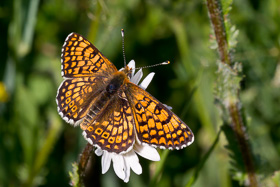 | 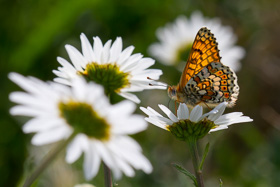 |
| Glanville Fritillary Image © Peter Eeles | Glanville Fritillary Image © Peter Eeles |
If, having read the previous sections, you want to pursue a captive rearing project, then this section and those that follow provide a primer on how to get started. These sections are not, however, a comprehensive guide since this would warrant a book in itself. Cribb (2001) and Friedrich (1988) are both recommended reading for those wanting more detail and, especially, species-specific information.
Once you have taken into account your reasons for captive rearing and your position on releasing (covered in the previous sections of this article) and have decided to proceed, then you will already have narrowed down the list of species that are candidates for captive rearing. However, there are a few more things to consider.
First off, if this is your first attempt at captive rearing, then start with a small number of a common species that is widespread and local to you. Species such as Small White (Pieris rapae), Large White (Pieris brassicae), Peacock (Aglais io) and Small Tortoiseshell (Aglais urticae) are good candidates. These species don't take a lot of looking after, a detailed knowledge of their ecology is not a prerequisite to a successful outcome and you are unlikely to disrupt any conservation activities. Once you have a better appreciation of what it takes to successfully rear a simple species in captivity you might try something more adventurous.
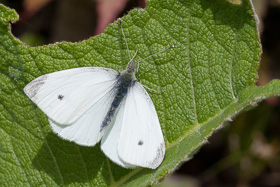 | 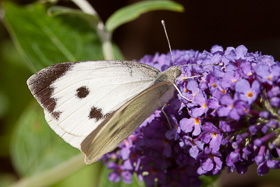 |
| Small White Image © Peter Eeles | Large White Image © Peter Eeles |
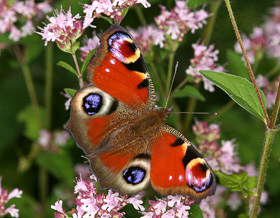 | 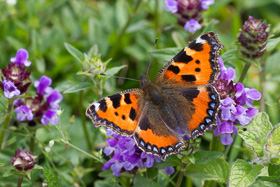 |
| Peacock Image © Peter Eeles | Small Tortoiseshell Image © Peter Eeles |
I am not sure what the equivalent motto of "A dog is for life, not just for Christmas" (that you see posted in dog lovers' cars) is for Lepidoptera, but the sentiment is the same. If you are going to rear any species in captivity, then you need to act responsibly and understand the needs of the species before you start. One of the reasons for writing this article is an increasing occurrence of enthusiasts taking livestock from the wild (or obtaining it from a dealer) without having much clue about its needs, including the larval foodplant, what stage the species will overwinter in, the fact that the larvae are cannibalistic and so on. The section on "Techniques", below, discusses each of these points and more.
There are two possible ways to get hold of livestock: obtain it from a dealer (or fellow enthusiast) or take it from the wild. When obtaining from a dealer, please be aware of the concerns discussed earlier regarding releases. You might want to quiz the dealer on the provenance of their stock, for example.
Unsurprisingly, there are several laws that have something to say about taking livestock from the wild (which includes the taking of gravid females with the intention of obtaining eggs). However, this is a complex area to digest, given the number of laws involved (some are Europe-wide and others country-specific, for example). An excellent summary is provided in Buglife (2014) and the relevant elements included here.
The countries of the UK (England, Scotland, Wales and Northern Ireland) all implement the Wildlife and Countryside Act (1981) either directly (in the case of England and Wales) or indirectly (in the case of Scotland and Northern Ireland) through local legislation with subtle, if any, differences. Section 9 of the Wildlife and Countryside Act (which covers animals other than birds) outlines the protection given to species listed in Schedule 5, where full protection is defined in section 9 by the following subsections:
The upshot is that none of the fully-protected species that are listed (given below) can be taken from the wild and, if you obtain stock from a dealer, then the onus is on you (see subsection 6) to prove that either the stock does not originate in the British Isles, or that it was captive bred from stock that was taken from the wild before that species was scheduled.
The following butterfly species have full protection, where all parts of section 9 apply (the date shown with each species indicates when it was "scheduled"):
Heath Fritillary (Melitaea athalia, 1992), High Brown Fritillary (Argynnis adippe, 1992), Large Blue (Maculinea arion, 2007), Large Copper (Lycaena dispar, 1992), Marsh Fritillary (Euphydryas aurinia, 1998), Swallowtail (Papilio machaon, 1992).
The following moth species also have full protection:
Barberry Carpet (Pareulype berberata, 1981), Black-veined (Siona lineata, 1981), Essex Emerald (Thetidea smaragdaria, 1981), Fiery Clearwing (Pyropteron chrysidiformis, 1998), Fisher's Estuarine (Gortyna borelii, 1998), New Forest Burnet (Zygaena viciae, 1981), Reddish Buff (Acosmetia caliginosa, 1981), Slender Scotch Burnet (Zygaena loti ssp. scotica, 2011), Sussex Emerald (Thalera fimbrialis, 1992) and Talisker Burnet (Zygaena lonicera ssp. jocelynae, 2011).
The Wildlife (Northern Ireland) Order (1985) gives the following butterfly species full protection:
Brimstone (Gonepteryx rhamni, 1985), Dingy Skipper (Erynnis tages, 1985), Holly Blue (Celastrina argiolus, 1985), Large Heath (Coenonympha tullia, 1985), Marsh Fritillary (Euphydryas aurinia, 1985), Purple Hairstreak (Favonius quercus, 1985) and Small Blue (Cupido minimus, 1985). Real's Wood White (Leptidea reali) was added in 2011, but this will presumably be amended to the actual species found in Northern Ireland: the Cryptic Wood White (Leptidea juvernica).
The Wildlife (Isle of Man) Act (1990) gives full protection from taking, killing, possession, selling and advertising for sale two species of moth: the Grey (Hadena caesia) and the Scarce Crimson and Gold (Pyrausta sanguinalis).
The only species of Lepidoptera protected in the Republic of Ireland is the Marsh Fritillary (Euphydryas aurinia) which is protected under the EU Habitats Directive (2007).
The following species have partial protection and are covered by section 5 (both subsections (a) and (b)) of the Wildlife and Countryside Act (1981) and, as such, are characterised as being protected for "Sale only" (the species cannot be sold or bought if taken from the wild). All species were scheduled in 1989:
Adonis Blue (Polyommatus bellargus), Black Hairstreak (Satyrium pruni), Brown Hairstreak (Thecla betulae), Chalk Hill Blue (Polyommatus coridon), Chequered Skipper (Carterocephalus palaemon), Duke of Burgundy (Hamearis lucina), Glanville Fritillary (Melitaea cinxia), Large Heath (Coenonympha tullia), Large Tortoiseshell (Nymphalis polychloros), Lulworth Skipper (Thymelicus acteon), Mountain Ringlet (Erebia epiphron), Northern Brown Argus (Aricia artaxerxes), Pearl-Bordered Fritillary (Boloria euphrosyne), Purple Emperor (Apatura iris), Silver-Spotted Skipper (Hesperia comma), Silver-Studded Blue (Plebejus argus), Small Blue (Cupido minimus), White-Letter Hairstreak (Satyrium w-album) and Wood White (Leptidea sinapis).
Specific provisions are also made for specially-designated land when it comes to taking butterflies or moths from the wild. Unsurprisingly, SSSIs, nature reserves, National Trust land and many other organisations and private landowners do not allow, without consent, the killing or removal of any fauna.
Whatever the law says, common sense should still prevail. Fragile sites and fragile species (at a given site) are best left alone, whether they are protected or not, otherwise there is a real potential for local extinctions.
Having decided to embark on a captive rearing project with a particular species, there are some general principles that should be considered as discussed below.
Possibly the most important principle of all is to keep the livestock in the most natural conditions possible. While some of those conditions may be species-specific (for example, White Admiral (Limenitis camilla) larvae live in shade or dappled sunlight in the wild), the golden rule is to allow the livestock to experience all of the weather conditions since, after all, this is what they have evolved to survive and, in many cases, rely on. Bringing livestock indoors (even if in an outhouse, such as a shed or garage) can create artificially warm, dry and dark conditions that will harm, rather than help.
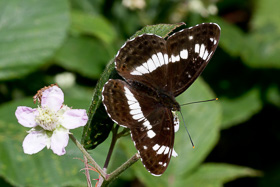 | 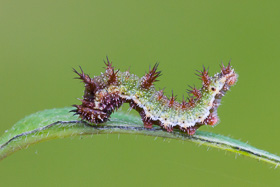 |
| White Admiral Image © Peter Eeles | White Admiral larva Image © Peter Eeles |
Particular problems can arise when conditions are not in step; the larval foodplant can be difficult to come by and adults might emerge out of sync with their wild counterparts. I've made this mistake myself, where a rescued Purple Hairsteak (F. quercus) egg (kept in a shed, that received a fair amount of sun, over the winter) emerged about a month before it should have. I had to look far and wide for oak leaves (the larval foodplant) that had burst from their buds that spring and, no matter what I did to try and slow the larval development (such as keeping the larva in cool conditions), the resulting adult emerged 3 weeks earlier than desired. I only hope the adult survived long enough to find a mate and procreate.
Most species require their rearing cages to be kept in full sun (especially for the ultra violet light part of the spectrum) during at least some part of their development. Their foodplants also require sunlight to photosynthesise and grow, and thereby produce sufficient nutrition for any larvae. Also, some species rely on sunlight to aid their digestion, such as the gregarious larvae of the Marsh Fritillary (E. aurinia). Depriving larvae of ultra violet light (by keeping them under glass, for example) can also result in their death, since bacteriological infections thrive under such conditions.
It should also be mentioned that cages typically have black and fine-meshed netting that can create an artificial microclimate, where internal conditions are more extreme than those outside of the cage and this should be accounted for. Smaller cages are usually better for larvae since the smaller surface area of the cage means that it is more likely to be synchronised with the external conditions. However, larger cages are often used for purely practical reasons; it can mean that foodplant does not need to be replenished as frequently, larvae do not need to be moved to cages containing fresh foodplant, more stock can be reared and that larvae are less stressed since they are able to move more freely in less-cramped conditions.
However, one large cage for all your livestock is not usually a good idea since you are, literally, putting all of your eggs in one basket and an outbreak of disease can be disastrous. "If significant numbers of larvae are being reared then it is advisable to repeatedly divide the incumbents of each cage into two and place each part thereof into fresh cages with fresh plant material, typically doubling the number of cages at each instar. Also, stock should be released into the wild (if that is the intention) before it starts to compete for resources." (White, 2014. pers. comm.)
Aside from sunlight, rain and wind should also be mentioned. Under prolonged or very heavy rain cages can be tipped sideways, typically facing south, to reduce the surface area exposed to such inclement weather. Cages can be placed inside a washing-up bowl, which can be angled precisely by placing a brick (or other object) underneath. Also, cages should not be sheltered from wind as any increase in internal airflow is highly desirable.
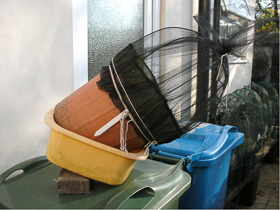 |
| Reducing the effects of heavy or prolonged rain Image © Martin White |
Another simple but often-forgotten consideration is ensuring that you have time to tend to the livestock. One of the reasons that Frohawk took 24 years to rear all of the British butterfly species is that, in order to do his studies justice (recording and illustrating all aspects of the immature stages), he could rear only a limited number of species in any given year. Time needs to be dedicated to obtaining foodplant (if cut), tending to the foodplant (such as watering it), moving larvae to fresh foodplant, cleaning out cages, checking for disease and so on. The amount of time required should not be underestimated and you will need more than you think.
You also need to be present at critical points during the lifecycle so that newly-emerged larvae can be transferred to the foodplant (if required), pupae can be transferred to an emerging cage, adults can be fed before being transported to the release site, and so on. Those that are frequently away from home (and I fall into this category) need to bear this in mind.
Some basic knowledge of the species that you are intending to rear is also needed and, while the items in the following list will sound obvious, I have come across examples where each of the following has been conveniently ignored as enthusiasm exceeds the practicalities.
You should know what foodplant the larva uses and if that is not available then a suitable alternative: see Allan (1979) and May (2003). Also be aware that a larva may use one plant in preference to another based on the location from where it originated and this should be accommodated.
You should have sufficient quantities of larval foodplant that is in good condition. Do not underestimate the amount that each larva will consume. I remember rearing the Death's Head Hawk-moth (Acherontia atropos) when I was younger. The dozen or so eggs I was given resulted in the loss of large quantities of privet in my neighbourhood. Also, some larvae do not take well to a change in foodplant so do not plan on being able to switch from one foodplant to another.
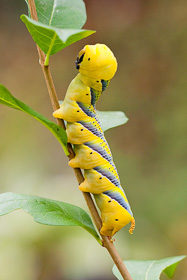 |
| The Death's Head Hawk-moth larva has a voracious appetite Image © Peter Eeles |
You should be aware if the larvae are cannibalistic and keep them separate as appropriate. In the British butterflies, the larvae of the Orange-tip (Anthocharis cardamines) and Green Hairstreak (Callophrys rubi) are notorious for their ability to do away with their brethren.
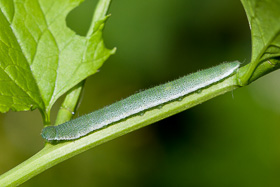 | 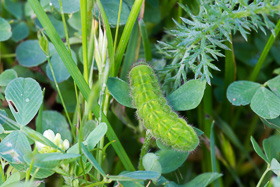 |
| Orange-tip larva Image © Peter Eeles | Green Hairstreak larva Image © Peter Eeles |
You should know something about the phenology of the species (when the lifecycle stages occur during the course of a year). For example, rearing a larva that overwinters is considerably more difficult than one that does not, since different factors come into play (such as the provision of dead and sterilised leaves within which the larvae can hibernate, if relevant, and the need to monitor any build up of moisture which could lead to a fungal attack).
Finally, it should be said that rearing purely for photographic opportunities is difficult to justify. The reasons for captive rearing given at the start of this article are much more palatable to anyone who really cares about nature. Whatever the reason for captive rearing, it is essential to keep a record of what has been done so that lessons can be learned and valuable findings passed on to the wider community.
Cribb (2001) provides a nice summary of potential predators when captive rearing. The key to avoiding predation is to use sterile soil, a sterile cage, clean foodplants (that might harbour a predator), netting with a fine mesh and secure ties or zips (that provide access to any cage or sleeve). The predators to watch out for include:
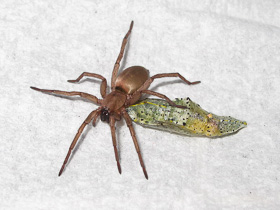 |
| Large White pupa being attacked by a spider Image © Vince Massimo |
Cages containing adults should also be protected from a potential bird attack. When I was much younger I vividly remember finding a spectacular Emperor moth (Saturnia pavonia) larva on my neighbour's Cotoneaster and deciding to rear it through to adulthood. When a beautiful female moth emerged, I decided to leave her in a cage in the back garden to see if any male moths would "assemble". When I looked the following morning, the cage was full of holes, the female Emperor moth was gone and the wings of several males were scattered around the outside of the cage. At the time we had a very strong Starling population (and I fondly remember watching their "murmurations" with my father) and I suspect that they were responsible for the devastation.
"The would-be breeder must first be something of a horticulturalist" (Cribb, 2001).
One of the side effects of captive rearing is that you also, largely out of necessity, become interested in horticulture and botany. In terms of horticulture, I've become familiar with the provisions that must be made when growing from seeds and plugs for a wide variety of species. In terms of botany, when I now go for a ramble through the countryside, I take as much interest in potential larval foodplants as I do any adult butterfly or moth I might see, especially as I might find an immature stage or two. It always gives me great pleasure, when supporting a guided walk, to be able to show attendees ova, larvae and even pupae (Red Admiral (Vanessa atalanta) pupae are particularly easy to find) when out and about. All you need is some experience and a knowledge of the species' phenology and ecology (including larval foodplants).
One of the most important considerations is whether to use growing or cut foodplant. Growing foodplant is always preferable, for obvious reasons (such as some plants deteriorating when cut and the desire to keep conditions as natural as possible).
If obtaining cut foodplant, try to ensure that it is unlikely to have been treated in any way, or exposed to a substance that would be harmful to the immature stages. This generally means avoiding the edges of farmland (which may have been treated with insecticide) and roadside verges (that may be contaminated with oils and other undesirable substances from passing vehicles). All cut foodplant should be thoroughly cleaned and dried off before use.
Plants also respond differently to being cut. Some will last for quite a while if simply placed in a jam jar with the tops plugged, or placed is some "oasis" material (as used in flower arranging). Plants as varied as Garlic Mustard (Cardamine pratensis) and Oak (Quercus sp.) seem to do very well, to the point that they only need changing every few days. Other plants make it very clear that being cut was not appreciated. Common Stinging Nettle (Urtica dioica), for example, will immediately droop once cut.
Also, be aware that some cut foodplants may appear to be fine, but the larvae feeding on them are not. For example, it is well-known that Purple Emperor (A. iris) larvae do not do well on cut Sallow (Salix spp.). Also, if overwintering cut foodplant, conditions that are too moist and poorly ventilated can result in disease that then spreads to the livestock. If more suitable conditions cannot be provided, then foodplant should be thoroughly dried out or the leaves removed.
Cut foodplant may also be placed in an airtight plastic container. To avoid a buildup of condensation, a lining of tissue paper should be added and both liner and foodplant replaced daily, with any larval frass removed. Plastic containers should really be considered a last resort, since it is very easy for mould to take hold, although it is surprising how many novices start with their use in mind.
Growing foodplant is always preferred, whatever the species, and a sensible option is to plan ahead and grow the required foodplant from seeds or plugs before you need it. This, in itself, needs some skill to ensure that the plants are watered correctly and receive the appropriate nutrients required. For example, both Chalk Hill Blue (P. coridon) and Adonis Blue (P. bellargus) feed on Horseshoe Vetch (Hippocrepis comosa) a "calcicole" that grows best in chalky soil. Other plants may require a soil that is very poor in nutrients.
Despite the effort required to ensure a supply of growing foodplant, the results are well worth it; most enthusiasts find that they have more success. In addition to growing from seeds and plugs, plants may also be purchased from a garden centre or nursery or possibly taken from the wild (but be aware that this may be illegal depending on the plant and the site).
Growing plants can be placed in a suitable cage and located somewhere suitable outside, but there are 2 variations on this theme. The first is a flowerpot cage where a frame is placed within the pot (or tub for larger plants) and a cylindrical net is placed around the frame and the pot, and then tied at either end. Insectopia (2014) provides a nice selection of this arrangement. Larger plants, such as a Sallow, can be "sleeved". In this case you take some netting that has been sewn into a cylindrical shape, place the net over a branch, and tie at each end. You may also choose to include some apparatus to ensure that the netting is kept away from the foodplant.
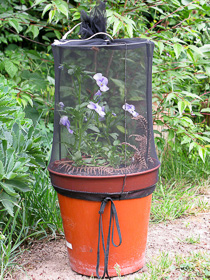 | 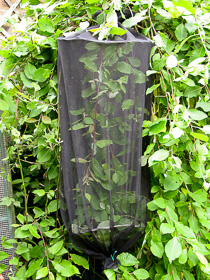 |
| A flowerpot cage containing Silver-washed Fritillary larvae Image © Peter Eeles | A sleeve containing Purple Emperor larvae Image © Peter Eeles |
As a general rule, eggs that do not overwinter hatch in around 10-14 days (Friedrich, 1988) and the larval foodplant needs to be ready at this point, unless the larvae overwinter without feeding. Overwintering eggs, such as those of the Brown Hairstreak (Thecla betulae), can be safely kept in a fridge to prevent hatching and brought out when the time is right (and in sync with those in the wild). This is a viable alternative to keeping the eggs in a cool place (such as a shed) where there is the potential for the eggs to emerge early or develop a fungal infection if conditions are too moist and poorly ventilated, when infection can invade the egg.
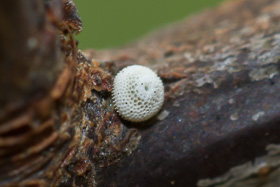 |
| Some eggs overwinter, such as those of the Brown Hairstreak Image © Peter Eeles |
If eggs have been laid by a caged female then, as a general rule, eggs laid on the cage and netting should not be removed; the eggs of many species are very fragile, as are newly-laid eggs, and are easily damaged.
The larval stage is where most effort is required, mainly because it is the only stage where growth occurs and there is, therefore, a need to provide foodplant.
It was mentioned earlier that certain factors can cause stress in larvae which, in turn, lead to disease, although the symptoms may not be immediately visible. New (2014) suggests that "Latent viruses may not appear for several generations of putative host 'stress' ... but might then have serious effects on survival or performance, such as by inducing sterility or loss of fecundity". Stress factors include a lack of sufficient foodplant so that larvae go hungry, being too crowded (unless the species is gregarious in the larval stage), major temperature changes and foodplant that is too wet (and artificially spraying the foodplant with water, unless absolutely necessary, can also cause infection if frass partially dissolves and is eaten by the larvae).
If a larva stops feeding then it does not automatically mean that it is diseased. It may simply be preparing for a skin change, preparing to pupate, or preparing to overwinter, depending on the species. In all cases, the larva should be left alone and not forcibly moved since physical damage can be caused. A larva preparing to moult (or pupate) can be accidentally removed from its silk pad and subsequently fail to shed its skin properly and die. If any larvae are found to be diseased, then they must be removed, the foodplant replaced and the container thoroughly cleaned.
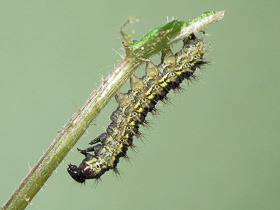 | 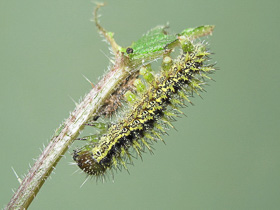 |
| A Small Tortoiseshell larva preparing to moult Image © Vince Massimo | Larva immediately after moulting Image © Vince Massimo |
One indicator of good captive rearing conditions is that there is no need to move larvae at all. Even transferring to fresh foodplant (if using cut foodplant) can normally be achieved by simple placing the new cuttings next to the old cuttings and letting the larvae move across themselves. Those that do not move are probably preparing for a skin change, in which case the foodplant (or liner, depending on where the larva has created its silk pad) can be trimmed and placed next to the new cuttings.
If there is a need to move a larva (for example, it may have escaped from the cage being cleaned) then a soft artist's brush can be used to transfer the larva back to the foodplant. I find that a small teaspoon is also useful for those larvae that, when disturbed, fall from the foodplant and curl up into a ball, remaining motionless for a few minutes.
It goes without saying that cannibalistic larvae should be kept apart. Larvae of very differing sizes should also be kept apart, since the larger will disturb the smaller (for example, while the smaller is preparing to undergo a skin change).
Particular attention should be paid to the pupation requirements of the larvae. Some species, such as the Small Tortoiseshell (A. urticae), hang head down from their cremaster prior to pupation. Others, such as the Orange-tip (A. cardamines), will construct a silk girdle to hold themselves in place and will need twigs of a particular thickness and angle on which to build their platform. The Grayling (Hipparchia semele) and many moth species require a layer of soil in which they will pupate. Others species might need dead leaves, or a layer of moss. The Puss Moth (Cerura vinula) larva (and related "kitten" species) will need some bark on which they can build their cocoon. I well remember my first wooden cage, which was severely compromised when several Puss Moth larvae used the wood of the cage to build their cocoons. A failure to provide the right conditions can result in larvae wandering for, literally, days as they search out a suitable place to pupate.
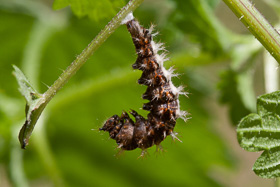 | 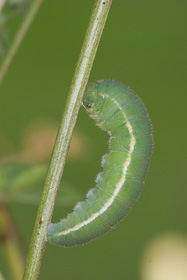 |
| Comma larva preparing to pupate Image © Peter Eeles | Clouded Yellow larva preparing to pupate Image © Peter Eeles |
In all cases, you should be aware of the requirements of the species and provide the conditions required. You should be prepared for larvae that decide to pupate on the cage and netting, no matter how much foodplant or how many twigs are provided. Also, be aware that some larvae will change colour or eject liquid frass before pupating; these are usually all perfectly normal signs and do not indicate that the larva is diseased in any way.
Once the pupa has formed it should remain undisturbed until the adult emerges. If it does need to be moved (for example, when it has formed on the zip opening to a cage), then wait at least 48 hours before doing this, so that the pupa can harden and be less susceptible to any damage caused by handling. Pupae that are close to the emergence of the adult should also be undisturbed since, again, there is a potential to cause damage.
If you choose to move pupae to a separate emergence cage then it is best to leave the pupa in situ for those species that attach themselves to the foodplant or other movable surface, rather than risking damage to the cremaster or other part of the pupa. If the pupa is attached to the netting of the cage in which the larva was reared then it can be moved by carefully removing any silk pads (that the larva may have created) from the netting (but leave the pupa attached to the silk pads). It might then be possible to glue the silk pads to an alternative surface, such as a twig, before placing in the emergence cage. Pupae that are formed under the soil (such as those of the hawk-moths) are best left well alone for some time after the larvae have burrowed into the soil, since it is impossible to know whether the resulting pupae are hard enough to move, and there is a danger of damaging newly-formed pupae when rummaging around in the soil.
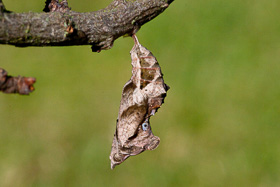 | 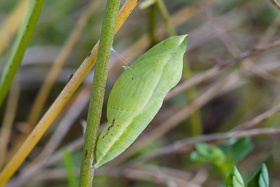 | 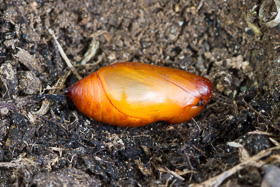 |
| Comma pupa Image © Peter Eeles | Clouded Yellow pupa Image © Peter Eeles | Grayling pupa Image © Peter Eeles |
As with the other immature stages, the pupa can be affected by fungus if conditions are too moist with insufficient ventilation. Also, be aware that any disease that may appear in the pupa (which often appears as some asymmetric discolouration), may well be the result of a disease that was contracted in the larva.
Emerging adults must be able to hang from an appropriate platform as their wings expand and dry. This may be their pupal case, the netting on the side of an emergence cage or some other platform, such as twigs, that have been placed in the cage with them. The adults should be left undisturbed for a few hours, at least, while their wings expand and harden and I personally never disturb any emerging adult that has not made its first flight since only then do I know that the wings are completely dry.
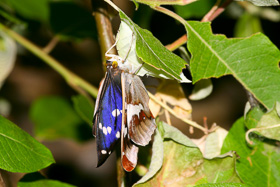 |
| Purple Emperor male drying its wings Image © Peter Eeles |
Emerging adults should not be overcrowded since there is the potential for them to disturb each other. One sign of disturbance is an adult whose wings have not expanded properly and such "cripples" do not always fare well once released.
If you need to bide a small amount of time before you are able to travel to the release site (or the weather is particularly inclement), then it may be necessary to feed the adults. Adults should always be provided with water soaked into a suitable material, such as an oasis block, since the cage netting creates a microclimate where the average temperature is artificially high. Nectar can also be provided in the form of cut flowers placed in a jam jar. An alternative is a sugar or honey solution, where a mix of 5-10% fructose sugar or honey is mixed with boiled water, allowed to cool, soaked into a suitable material and then placed as a pad on top of the netting of any flight cage. It is best not to use normal domestic sugars as these crystallise in the digestive system of the adult insect and ultimately kill them. Pads should be changed regularly before they become mouldy.
Butterflies and day-flying moths are best released the day after they have emerged, around mid-morning when the temperature is sufficiently high to allow them to take to the wing. Night-flying moths are best released at dusk when they will become active and also avoid the attention of birds.
If the adults need to be transported to the release site, then keeping them in cool and dark conditions will ensure that they remain inactive and do not harm themselves. Adults can be safely kept in an airtight container in a fridge (but not a freezer, which will kill them) prior to being transported. A cooler bag containing ice packs is usually sufficient for the actual journey itself, with the boxes containing the adults placed in the same bag, but separated from the ice packs with a cloth or towel otherwise they might get too cool and the adults may come to harm.
This article does not go into details of breeding a subsequent generation since it is assumed that the adults will be released. Captive breeding is beyond the scope of this article and entails a new set of considerations. For example, most butterfly species rely on sight, rather then scent, to attract a mate and this may also involve an elaborate courtship, an obvious example being that of the Silver-washed Fritillary (A. paphia), where the male circles the female while in flight. Those interested in captive breeding rather than captive rearing should consult Cribb (2001) and Friedrich (1988).
Captive rearing can add a new dimension to an already-enthralling hobby. However, it should only be attempted, if at all, with a solid understanding of the reasons for captive rearing, a perspective on what you will do with the resulting adults, knowledge of how to choose and source a suitable species and an appreciation of the techniques that should be applied to ensure success.
I would like to thank Mark Colvin, Richard Fox, Dan Hoare, Colin Knight, Vince Massimo, Tim Norriss, Guy Padfield, Martin Warren and Martin White for their input and review comments. I would also like to thank the many members of the UK Butterflies community who indulged me with a discussion on captive rearing that informed this article.